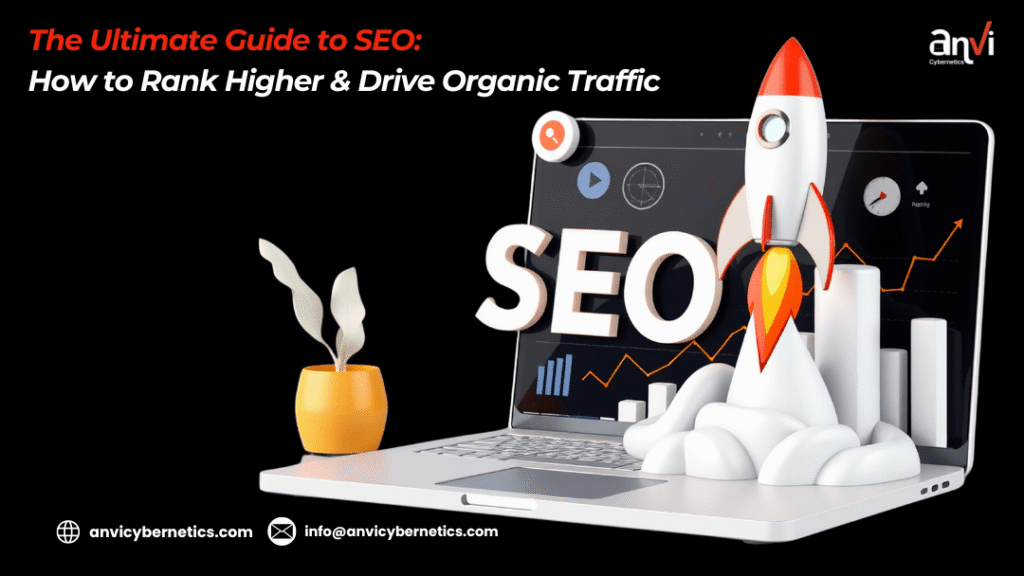
The Ultimate Guide to SEO: How to Rank Higher and Drive Organic Traffic.
In the world of digital marketing, SEO (Search Engine Optimization) is the backbone of any successful online strategy. SEO helps businesses rank higher on search engines like Google, increasing visibility and driving organic traffic. If you’re looking to rank higher and get noticed, this ultimate guide to SEO will break down everything you need to know to get started.
1. Understanding SEO: The Foundation for Success
SEO involves optimizing various elements of your website so search engines like Google can easily crawl, index, and rank your content. There are several components of SEO, including:- On-Page SEO: Optimizing elements on your website, such as content, HTML code, and structure.
- Off-Page SEO: Building authority through backlinks, social signals, and other external factors.
- Technical SEO: Ensuring search engines can efficiently crawl and index your website by improving site speed, mobile optimization, and security.
- Content SEO: Creating valuable, relevant content that satisfies user intent and incorporates targeted keywords.
2. Keyword Research: Targeting the Right Audience
Keyword research is the foundation of any successful SEO campaign. It involves identifying relevant, high-traffic keywords that your audience is searching for.- Primary Keywords: These are broad terms that define your core services or products. For example, if you’re targeting “digital marketing services,” you would focus on that as a primary keyword.
- Secondary Keywords: Long-tail keywords and variations that target specific needs or questions your audience may have. For example, “affordable SEO services for small businesses” would be a secondary keyword.
3. On-Page SEO Optimization Techniques
On-page SEO refers to the optimization techniques you apply directly to your website pages to improve rankings. Title Tags and Meta Descriptions Title tags and meta descriptions are critical for both user experience and SEO. Here’s how to optimize them:- Title Tag: Use primary keywords and keep it under 60 characters to ensure it appears fully in SERPs.
- Meta Description: Incorporate keywords naturally and provide a compelling reason for users to click. Keep it under 160 characters.
Header Tags (H1, H2, H3)
Structure your content using headers to improve readability and SEO. Use H1 tags for the main title, and include relevant keywords in H2 and H3 tags for subheadings. This helps search engines understand the hierarchy and importance of your content.Content Optimization
Your content should:- Be informative and aligned with the searcher’s intent.
- Include primary and secondary keywords naturally.
- Answer user questions and provide value.
Internal Linking
Use internal linking to guide users through your website. For example, if you’re discussing digital marketing services, link to your Growth Marketing or SEO Services pages. Internal links distribute page authority across your site and improve the user experience by helping visitors discover related content.4. Off-Page SEO: Building Authority Through Backlinks
Off-page SEO primarily focuses on building your website’s authority through backlinks. Backlinks from high-authority, relevant websites signal to search engines that your content is valuable and trustworthy.Strategies for Earning Quality Backlinks
- Guest Blogging: Write guest posts on reputable industry websites and include backlinks to your site.
- Content Outreach: Create valuable content such as case studies or infographics that others would want to link to.
- Social Media Sharing: Promote your content across social media platforms to increase visibility and encourage others to link back to your website.
5. Technical SEO: Improving Your Website’s Crawlability
Technical SEO involves optimizing the backend of your site to ensure it’s easily crawled by search engines.Key Technical SEO Factors
- Site Speed: Ensure your website loads quickly by compressing images, leveraging browser caching, and minimizing JavaScript.
- Mobile-Friendliness: Google’s mobile-first indexing means your site needs to be fully optimized for mobile devices. Ensure a responsive design.
- Secure Website (HTTPS): Use HTTPS to secure user data and improve your rankings. Google gives preference to secure websites.
1. Understanding SEO: The Foundation for Success
SEO involves optimizing various elements of your website so search engines like Google can easily crawl, index, and rank your content. There are several components of SEO, including:- On-Page SEO: Optimizing elements on your website, such as content, HTML code, and structure.
- Off-Page SEO: Building authority through backlinks, social signals, and other external factors.
- Technical SEO: Ensuring search engines can efficiently crawl and index your website by improving site speed, mobile optimization, and security.
- Content SEO: Creating valuable, relevant content that satisfies user intent and incorporates targeted keywords.
2. Keyword Research: Targeting the Right Audience
Keyword research is the foundation of any successful SEO campaign. It involves identifying relevant, high-traffic keywords that your audience is searching for.- Primary Keywords: These are broad terms that define your core services or products. For example, if you’re targeting “digital marketing services,” you would focus on that as a primary keyword.
- Secondary Keywords: Long-tail keywords and variations that target specific needs or questions your audience may have. For example, “affordable SEO services for small businesses” would be a secondary keyword.
3. On-Page SEO Optimization Techniques
On-page SEO refers to the optimization techniques you apply directly to your website pages to improve rankings. Title Tags and Meta Descriptions Title tags and meta descriptions are critical for both user experience and SEO. Here’s how to optimize them:- Title Tag: Use primary keywords and keep it under 60 characters to ensure it appears fully in SERPs. For example, “Expert SEO Services for Business Growth | Anvi Cybernetics.”
- Meta Description: Incorporate keywords naturally and provide a compelling reason for users to click. Keep it under 160 characters.
Header Tags (H1, H2, H3)
Structure your content using headers to improve readability and SEO. Use H1 tags for the main title, and include relevant keywords in H2 and H3 tags for subheadings. This helps search engines understand the hierarchy and importance of your content.Content Optimization
Your content should:- Be informative and aligned with the searcher’s intent.
- Include primary and secondary keywords naturally.
- Answer user questions and provide value.
Internal Linking
Use internal linking to guide users through your website. For example, if you’re discussing digital marketing services, link to your Growth Marketing or SEO Services pages. Internal links distribute page authority across your site and improve the user experience by helping visitors discover related content.4. Off-Page SEO: Building Authority Through Backlinks
Off-page SEO primarily focuses on building your website’s authority through backlinks. Backlinks from high-authority, relevant websites signal to search engines that your content is valuable and trustworthy.Strategies for Earning Quality Backlinks
- Guest Blogging: Write guest posts on reputable industry websites and include backlinks to your site.
- Content Outreach: Create valuable content such as case studies or infographics that others would want to link to.
- Social Media Sharing: Promote your content across social media platforms to increase visibility and encourage others to link back to your website.
5. Technical SEO: Improving Your Website’s Crawlability
Technical SEO involves optimizing the backend of your site to ensure it’s easily crawled by search engines.Key Technical SEO Factors
- Site Speed: Ensure your website loads quickly by compressing images, leveraging browser caching, and minimizing JavaScript.
- Mobile-Friendliness: Google’s mobile-first indexing means your site needs to be fully optimized for mobile devices. Ensure a responsive design.
- Secure Website (HTTPS): Use HTTPS to secure user data and improve your rankings. Google gives preference to secure websites.
6. Monitoring and Analytics: Tracking SEO Success
SEO is an ongoing process. Use tools like Google Analytics and Google Search Console to track your website’s performance.- Track keyword rankings: See which keywords are driving traffic and adjust your content strategy accordingly.
- Monitor organic traffic: Analyze the growth of organic traffic over time.
- Identify issues: Use Google Search Console to find crawl errors, broken links, or security issues that may affect your rankings.




